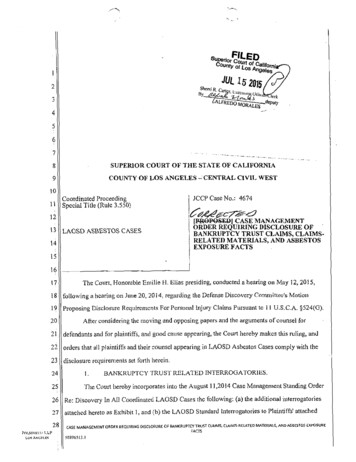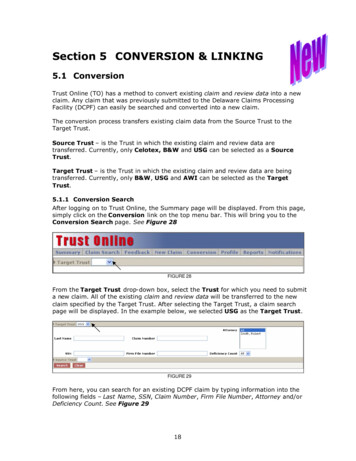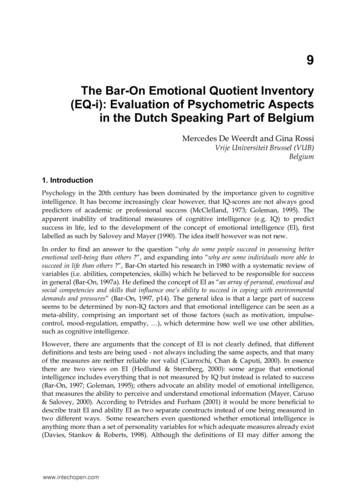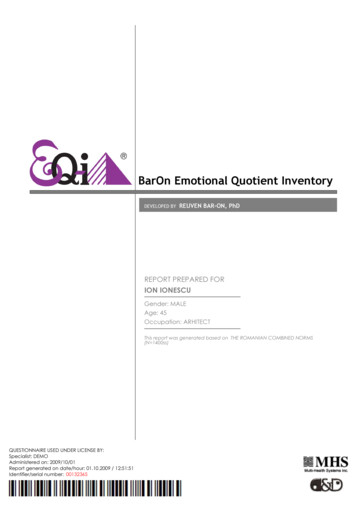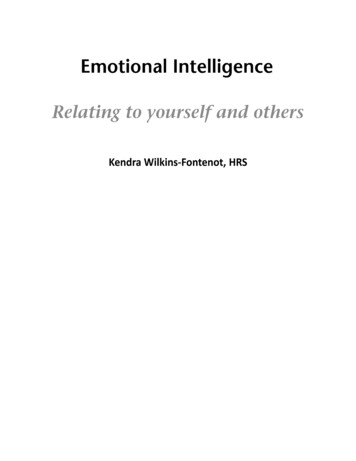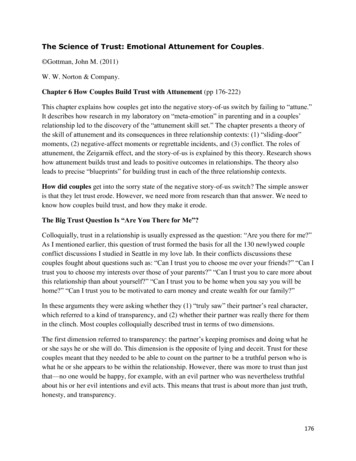
Transcription
The Science of Trust: Emotional Attunement for Couples. Gottman, John M. (2011)W. W. Norton & Company.Chapter 6 How Couples Build Trust with Attunement (pp 176-222)This chapter explains how couples get into the negative story-of-us switch by failing to “attune.”It describes how research in my laboratory on “meta-emotion” in parenting and in a couples’relationship led to the discovery of the “attunement skill set.” The chapter presents a theory ofthe skill of attunement and its consequences in three relationship contexts: (1) “sliding-door”moments, (2) negative-affect moments or regrettable incidents, and (3) conflict. The roles ofattunement, the Zeigarnik effect, and the story-of-us is explained by this theory. Research showshow attunement builds trust and leads to positive outcomes in relationships. The theory alsoleads to precise “blueprints” for building trust in each of the three relationship contexts.How did couples get into the sorry state of the negative story-of-us switch? The simple answeris that they let trust erode. However, we need more from research than that answer. We need toknow how couples build trust, and how they make it erode.The Big Trust Question Is “Are You There for Me”?Colloquially, trust in a relationship is usually expressed as the question: “Are you there for me?”As I mentioned earlier, this question of trust formed the basis for all the 130 newlywed coupleconflict discussions I studied in Seattle in my love lab. In their conflicts discussions thesecouples fought about questions such as: “Can I trust you to choose me over your friends?” “Can Itrust you to choose my interests over those of your parents?” “Can I trust you to care more aboutthis relationship than about yourself?” “Can I trust you to be home when you say you will behome?” “Can I trust you to be motivated to earn money and create wealth for our family?”In these arguments they were asking whether they (1) “truly saw” their partner’s real character,which referred to a kind of transparency, and (2) whether their partner was really there for themin the clinch. Most couples colloquially described trust in terms of two dimensions.The first dimension referred to transparency: the partner’s keeping promises and doing what heor she says he or she will do. This dimension is the opposite of lying and deceit. Trust for thesecouples meant that they needed to be able to count on the partner to be a truthful person who iswhat he or she appears to be within the relationship. However, there was more to trust than justthat—no one would be happy, for example, with an evil partner who was nevertheless truthfulabout his or her evil intentions and evil acts. This means that trust is about more than just truth,honesty, and transparency.176
This leads us to the second dimension of trust: positive moral certainty about the partner. Wemust have a confidence and knowledge that our partner is an ethical, moral person—a goodperson, someone who will treat us and others with high moral standards, integrity, honesty,kindness, love, and goodwill. This second dimension of trust is about our partner’s intentions,motives, and actions toward us. It’s about the question: “Just where do I fit into my partner’smotivational scheme?” “Do I come first in some important sense, compared to other people ormy partner’s goal, or do other things take priority over me?” The question we are asking iswhether this colloquial use of the two dimensions of trust is related to our previously definedtrust metric. It turns out that they are totally related to each other, empirically.How Couples Build TrustPart of the news in this book is that trust is built by couples using the skill of “attunement.” Inthis chapter I am going to start describing this skill as a blueprint for building trust in long-termcommitted relationships.To create a constructive blueprint for building trust, it is necessary to discuss the use of theattunement skill in three different relationship contexts. As I have mentioned, the contexts forbuilding trust are like a folding fan. Each area of the fan is about the basic question of trust, “Areyou there for me?” These are micro trust tests, where trust has built up over time, or eroded overtime. Here are the three major trust-building contexts, or parts of the trust fan: (1) the everydayinteractions I call “sliding-door moments,” (2) regrettable incidents or past emotional injuries,and (3) conflict interactions.Sliding-door moments, the first part of the fan, are very small moments in which a need isexpressed and the responsiveness of one’s partner is a test of trust. In these moments we testwhether we can trust that our partner will turn toward our expressed need.The second part of the fan involves a moment in which at least one person is experiencingnegative affect and longs for a voice and connection with the partner. It can be a negativeemotion that is about the partner, or it can be just a personal negative emotion that is not aboutthe relationship at all. This second context also includes “regrettable incidents” that are about therelationship, in which we hurt our partner’s feelings or have an unfortunate argument.The third part of the fan involves an actual conflict discussion (Rapoport’s debate mode). In thiscontext a couple has decided to discuss an area of impending decision and they expect somedisagreement between them. In the next chapter I will also talk about how the skill of attunementis used by couples for building trust during another important part of the “trust fan”: the moreintimate romantic, passionate, and sexual moments.How the Attunement Skill Was Discovered177
Here’s the story of how the process of attunement in couples was discovered. In 1985 Ideveloped an interview I called the “meta-emotion” interview for parents.1 In this interview weasked people how they felt about specific feelings in themselves and in their children.The term “meta” is a reflexive word in psychology that sort of folds back on itself. Here’s what Imean. The term “meta-cognition” means how we think about our thinking. The term “metacommunication” refers to how we communicate about communication. By “meta-emotion,” Imean how we feel about feelings.We interviewed people separately. We used that interview to talk to parents about their history ofemotion—specific emotions like anger and sadness, but also emotion in general. We asked themhow they felt about their own feelings and about their children’s feelings, as well as about theirgeneral philosophy about emotions, emotional experience, and emotional expression. We askedquestions like: “What’s been your experience in your life with anger? with sadness?” “Could youtell growing up when your father was angry? What effect did this have on you?” “What has beenyour own relationship with anger?” “How did your parents show you that they loved you?”So what’s so special about this interview about how people experience emotion? The answer isthat people all over the planet experience and display at least seven basic emotions (anger,sadness, disgust, contempt, fear, interest, and happiness) in the same way. Carrol Izard and PaulEkman established these facts.2 For example, people have essentially the same spontaneousfacial expressions when they feel sad. When people feel sad the inner corners of their eyebrowsgo up and together, forming a brow that looks like an upside-down V. When people feel angrytheir brows tend to come down and together, forming a vertical furrow between their eyebrows;their upper lip may also tighten, or their lips may be pressed together. When people aresurprised, their entire brow goes up, their mouth may drop open, their upper eyelids raise, andtheir eyes become wide. When people are afraid, their brow becomes almost totally horizontal,the whites of their eyes may show, and their lips become tightly stretched horizontally. If theyfeel disgusted, their nose may wrinkle or their upper lip may become raised. If they feelcontempt, the left corner of their lip may be pulled to the side by the lateral muscle called the“buccinator” and a dimple may become evident; this may be accompanied by an eye roll. Thereis even evidence that people across the planet have the same autonomic physiological responsesto each emotion as well, although the “autonomic specificity hypothesis,” created by BobLevenson and Paul Ekman, is still controversial. For example, as part of this specificityLevenson and Ekman discovered that heart rate increases in fear and anger and decreases withdisgust. The hands become hot with anger and cold with fear.3Despite the universality of emotional expression and experience, there is huge variation acrosspeople in how they say they feel about each of these emotions, about their histories with specificemotions, and about emotional expression and their internal emotional experience. Weinterviewed people about the history of their experience with the emotions of anger, sadness,fear, affection, pride, and positive states such as play, fun, and adventure. We also asked them178
about their philosophy about emotion in general. We asked them how they experienced theseemotions growing up. We asked them how they and their partner experienced these emotions intheir relationship. Our interview is one way of linking individual therapy with couple therapy.This turned out to be a powerful interview. Let me give you an example. There was one womanwho described the deathbed scene of her father. She held his hand and said to him, “Dad, youhave never told me you love me. It would mean so much to me if you said it now.” Her fathersaid, “If you don’t know by now, you never will.” And then he died. She left his room furiouswith him, unable to mourn his death. We asked her what the effect of this experience was on her.She said that she was determined that not a day would pass without her telling her children thatshe loved them.I interviewed another woman who said that she and her sisters at a young age made a pact toalways convert their sadness into anger because they saw their mom depressed and bullied bytheir father. They decided that when she was 8 years old. From that time on she said that she wasnever sad; she was angry instead. How had this decision affected her? She is now a crusader inthe community for various social causes, and for their dyslexic son at school. When I then asked,“What do you do when Sam [her 4-year-old son] is sad?” She said, “I go for a run.” In thatfamily, Dad was the one who talked to Sam when he was sad.When we asked, “How did your parents show you that they were proud of you?” many peoplewept. They said that their parents never came to one of their games, or plays, or recitals. Whenwe asked them, “What are the implications of this for your own family?” people usually had a lotto say about expressing pride in their children.There was great variability in how people felt about feelings. For example, one man in our studysaid, “When someone gets angry with me it’s like they are relieving themselves in my face.” Butyet another man said, “Anger is like clearing your throat, natural, just get it out and go on.”These two fathers felt very differently when their children became angry with them.In that study we discovered that there were basically two types of parents in our data: “emotioncoaching” parents and “emotion-dismissing” parents. I am simplifying a bit here, because peoplecan be one way with a specific emotion and another way with another, so the results of the metaemotion interview are very complex. Some parents were very positive about their children’snegative emotions and acted like “emotion coaches.” Emotion coaches viewed their own andtheir children’s negative emotion as an opportunity for teaching or intimacy. They noticed lowerintensity negative emotions in their children. Overall they went through five steps during talkingabout an emotional event. I called these five steps “emotion coaching.” I will describe them in amoment.Other parents were trying to get their children to change what they viewed as their negativeemotions to positive emotions. They used many techniques, like distraction, or admonishing theirchildren to “roll with the punches” and change how they felt. They believed that the emotion one179
had was a choice, and therefore they were impatient with their children’s negative emotions.Their attitudes toward negative emotion were called “emotion dismissing,” which included beingdisapproving of the negative emotion.Here’s what emotion dismissing parents were like: They didn’t notice lower-intensity emotions in themselves or in their children (or inothers, either). In one interview we asked two parents about how they reacted to theirdaughter’s sadness. The mom asked the dad, “Has Jessica ever been sad?” He said hedidn’t think so, except maybe one time when she went to visit her grandmother alone andshe was 4 years old. “When she boarded the airplane alone,” he said, “she looked a littlesad.” But all children actually have a wide range of emotions in just a few short hours. Acrayon may break, and the child becomes immediately sad and angry. These parents justdidn’t notice much of Jessica’s more subtle emotions.They viewed negative affects as if they were toxins. They wanted to protect their childfrom ever having these negative emotions. They preferred a cheerful child.They thought that the longer their child stayed in the negative emotional state, the moretoxic its effect was.They were impatient with their child’s negativity. They might even punish a child just forbeing angry, even if there was no misbehavior.They believed in accentuating the positive in life. This is a kind of Norman VincentPeale, the power-of-positive-thinking philosophy. This is very American view. The ideais: “You can have any emotion you want, and if you choose to have a negative one, it’syour own fault.” So, they think, pick a positive emotion to have. You will have a muchhappier life if you do. So they will do things like distract, tickle, or cheer up their child tocreate that positive emotion.They see introspection or looking inside oneself to examine what one feels as a waste oftime, or even dangerous.They usually have no detailed lexicon or vocabulary for emotions.Here’s an example of an emotion-dismissing attitude. When asked about his daughter’s sadness,one father we interviewed said, “When she is sad I tend to her needs. I say, ‘What do you need?Do you need to eat something, go outside, watch TV?’ I tend to her needs.” This child mightconfuse being sad with being hungry. Here’s another example. A father said, “Say my kid has aproblem with other kids. Let’s say someone took something of his. I say, ‘Don’t worry about it.He didn’t mean it. He will bring it back. Don’t dwell on it. Take it lightly. Roll with the punchesand get on with life.’” This father’s message was: “Get over it. Minimize its importance.”The emotion-coaching philosophy was quite different from the emotion-dismissing philosophy.For example, for the same peer situation, another father we interviewed said, “If a kid were to bemean to him, I’d try to understand what he’s feeling and why. Some kid may have hit him ormade fun of him. I stop everything then; my heart just goes out to him and I feel like a father180
here and I empathize.” I interviewed one emotion-coaching couple in my lab. She was aprofessional cheerleader and he was a quarterback for a professional football team. She told methat the reason she liked her husband was that she once came across a smiley face calendar fromher youth when she was unpacking and moving in with her husband. She said that when she wasa little girl, if she were cheerful that day, her parents would put a smiley sticker on the calendar.If she got 20 smiley faces a month, she got to buy a toy. She hated that calendar. She said, “WhatI like about my husband is that I can be in a crabby mood and he still wants to be with me. Idon’t have to be cheerful.”Following is a summary of what we discovered about emotion-coaching parents: They noticed lower-intensity emotions in themselves and in their children. The childrendidn’t have to escalate to get noticed.They saw these emotional moments as an opportunity for intimacy or teaching.They saw these negative emotions—even sadness, anger, or fear—as a healthy part ofnormal development.They were not impatient with their child’s negative affect.They communicated understanding of the emotions and didn’t get defensive.They helped the child verbally label all the emotions he or she was feeling. What doeshaving words do? They are important. With the right words, I think the child processesemotions usually associated with withdrawal (fear, sadness, disgust) very differently. Ithink it becomes a bilateral frontal-lobe processing. Withdrawal emotions still areexperienced, but they are tinged with optimism, control, and a sense that it’s possible tocope.They empathized with negative emotions, even with negative emotions behindmisbehavior. For example, they might say: “I understand your brother made you angry.He makes me mad too sometimes.” They do this even if they do not approve of thechild’s misbehavior. In that way they communicate the value, “All feelings and wishesare acceptable.”They also communicated their family’s values. They set limits if there was misbehavior.In that way they communicated the value, “Although all feelings and wishes areacceptable, not all behavior is acceptable.” (We had other parents who did everythingelse in coaching but this step of setting limits, and their children turned out aggressive.)They were clear and consistent in setting limits to convey their values.They problem-solved when there was negative affect without misbehavior. They were notimpatient with this step, either. For example, they may have gotten suggestions from thechild first.They believed that emotional communication is a two-way street. That means that whenthey were emotional about the child’s misbehavior, they let the child know what theywere feeling (but not in an insulting manner). They said that was probably the strongest181
form of discipline, that the child is suddenly disconnected from the parent—less close,more “out.”Other things were different about these two types of emotion philosophy. In particular, the twogroups of parents were very different in the way they taught their children something new. Anhonors student named Vanessa Kahen-Johnson (now a psychology professor) discovered this.Emotion-dismissing parents taught their child in the following ways:They gave lots of information in an excited manner at first. They were very involved with the child’s mistakes.They saw themselves as offering “constructive criticism.”The child increased the number of mistakes as the parents pointed out errors. This is acommon effect during the early stages of skill acquisition.As the child made more mistakes, the parents escalated their criticism to insults, usingtrait labels such as “You are being careless” or “You are spacey.” They sometimes talkedto each other about the child in the child’s presence, as in: “He is so impulsive. That’s hisproblem.”As the child made more mistakes, the parents sometimes took over, becoming intrusive.In a book adult sons wrote about their fathers,4 a professional writer named ChristopherHallowell said that when he was 6, his dad said, “Son, I’m gonna teach you how to make a box.If you can make a box, you can do anything in the wood shop.” Chris’s first box was a littleshaky, but it had a lid. His dad examined it and said: “Chris this is a wobbly box. If you can’teven make a box, you can’t do anything in the wood shop.” Chris, at age 35, still has that box onhis nightstand. He still sees his dad’s face in the lid, saying, “Chris, you’ll never amount toanything.” Small moments can have huge implications for kids, because they tend to believetheir parents, even about themselves.In our lab not all children of emotion-dismissing parents did poorly on the task their parentstaught them. Some children with parents dismissing of their negative emotions during learningthe task got angry with their parents and did well on the lab task. They did well to spite theirparents. So the parents got a good performance out of their kid, but at the expense of trust. In herdissertation, a former graduate student of mine, Eun Young Nahm, compared parenting inKorean-American and Euro-American two-parent families with a 6-year-old child.5 The KoreanAmerican parents were primarily emotion-dismissing or disapproving, using shame-based tacticsto encourage their children during a tower-building task, while the Euro-American parents wereprimarily emotion-coaching, using praise-based tactics to encourage their children during thetower-building task. The Korean-American children did significantly better on the task than theEuro-American children. However, the levels of depression in the Korean-American childrenwere significantly higher than those of Euro-American children. Higher achievement in this casecame at an emotional cost.182
Vanessa Kahen-Johnson also discovered that emotion-coaching parents taught their children in adramatically different way from emotion-dismissing parents.6 Emotion-coaching parents: Gave little information to the child, but enough for the child to get started.Were not involved with the child’s mistakes (they ignored them).Waited for the child to do something right, and then offered specific praise and added alittle bit more information. (The best teaching offers a new tool, just within reach. Thenlearning feels like remembering.)The child attributed the learning to his or her own discovery.The child’s performance also went up and up.It’s important to point out that when we measured parental warmth, we found that emotiondismissing parents can be very warm. In our coding we found that warmth was statisticallyindependent of emotion coaching or dismissing. For example, a parent can very warmly say,“What’s wrong sweetheart? Put a smile on your face. There, that’s daddy’s little girl. Isn’t thatbetter now?” It is not cruel to be emotion-dismissing. Parents really mean well when they do it.In fact, I am not saying that emotion dismissing is “bad.” It is an action-oriented and problemsolving approach to problems. Both coaching and dismissing attitudes are important in parenting,but we discovered that they need to happen in the right sequence. For example, my daughterMoriah was once afraid of learning mathematics, and she discussed her fears with me. Iempathized with the fears and she felt a lot better. However, after all that understanding, sheactually did need to learn the math. Problem-solving and an action orientation is absolutelynecessary in life and in parenting. However, as Haim Ginott once said, advice is always moreeffective when words of understanding precede words of advice. First a child needs to feel thathe or she is not alone. We need to feel understood and supported. Then we are more likely to beable to turn toward action.It was interesting to me that emotion-dismissing and emotion-coaching people also had differentmetaphors about negative emotions. Dismissing people saw anger as like an explosion, likelosing control, or as aggression. Coaching people saw anger as a natural reaction to a blockedgoal. They suggested understanding the frustration, the goal, and what was blocking it. Thedismissing people saw sadness as wallowing in self-pity—as inaction and passivity, akin tomental illness—and they had metaphors of death. Coaching people saw sadness as somethingmissing in one’s life. They said that they slowed down to discover what was missing. Emotiondismissing people saw fear as cowardice, and inaction, as being a wimp. Coaching people saidthat fear was telling you that your world was unsafe. They said that when they felt afraid, theyfound out how to make their worlds safer. About negative emotion in general, dismissing peoplesaid feeling the negativity leads nowhere, that one should roll with the punches, get over it, goon. They viewed examining negative emotions as akin to pouring gasoline on an open fire, verydangerous.183
In short, coaching people said that exploring a negative emotion wasn’t dangerous or scary. Theysaid that it gave a person direction in life, like a GPS. Dismissing people thought of beingpositive as a choice, and they viewed dwelling on negative emotions as harmful and pessimistic.They thought it simply invited chaos.In our initial study, as we followed the 3-to 4-year-old children, there were consequences ofthese two types of emotion philosophy. We discovered that children who were emotion coachedat age 4 turned out to be very different at age 8, and at age 15, compared to the children ofemotion-dismissing parents:They had higher reading and math scores at age 8, even controlling statistically for IQdifferences at age 4.This effect was mediated through the attentional system.Coached children had better abilities with focusing attention, sustaining attention, and shiftingattention.Coached children had greater self-soothing ability even when upset during a parent-childinteraction.Coached children self-soothed better, delayed gratification better, and had better impulse control.Parents didn’t have to down-regulate negativity as much.Coached children don’t whine very much. Coached children had fewer behavior problems of allkinds (aggression and depression).Coached children had better relations with other children.Coached children had fewer infectious illnesses.As coached children got into middle childhood and then adolescence, they kept havingappropriate “social moxie.”Emotion-coaching parents also buffered the children in our sample from almost all the negativeeffects of an ailing marriage, separation, or a divorce (except for their children’s sadness). Thenegative effects that disappeared were: (1) acting out with aggression, (2) falling grades inschool, and (3) poor relations with other children.As Lynn Katz, Carol Hooven, and I reported in our book Meta-emotion, coached children, asthey develop, seem to have more emotional intelligence.The positive effects of teaching parents emotion coaching has been demonstrated in arandomized clinical trial by Sophie Havighurst in Australia,7 and in a large-scale school-based184
intervention by Dr. Christina Choi in two Catholic Boystown orphanages in Korea (in Seoul andBusan).8Teaching Emotion CoachingThere are only five steps in emotion coaching and there are now materials that teach this skill toparents.9 These five steps are not difficult to teach parents. They are:1.2.3.4.5.6.Noticing the negative emotion before it escalates.Seeing it as an opportunity for teaching or intimacy.Validating or empathizing with the emotion.Helping the child give verbal labels to all emotions the child is feeling.Setting limits on misbehavior, or problem-solving if there is no misbehavior.If the parent doesn’t do this last step, the kids tend to wind up becoming physically orverbally aggressive toward other children.It is interesting to note that our research showed that dads made a great deal of difference bothfor sons and for daughters. Fathers who emotion coached their children were better dads andbetter husbands. Their children felt closer to them, and moms appreciated them more. Duringconflict with their wives, emotion-coaching dads were not contemptuous; they were respectful.They knew their wives well and communicated a lot of affection and admiration to them in theoral history interview. They had a positive oral history switch. For the dads we studied, marriageand parenting was made of the same fabric. To read more about this meta-emotion study, see mybook with Joan DeClaire, Raising an Emotionally Intelligent Child, and my book with Lynn Katzand Carole Hooven, Meta-emotion.Attunement Is Emotion Coaching for CouplesThe term “coaching” suggests an asymmetry. Parents coach children, but children don’t coachparents. To generalize the concept of emotion coaching, we developed the idea of “attunement.”The idea of attunement is based on my former student Dan Yoshimoto’s coding of the couples’meta-emotion interview in his dissertation.10 Dan’s interview was an extension of our earlierwork on the parental meta-emotion interview. Dan’s doctoral thesis extended the meta-emotioninterview to couples and developed a new coding system for the new interview.Each partner was again interviewed separately. The interview was again very rich and a greatdeal of fun to do. We now think of the interview as a potential bridge between individual therapyand couples’ therapy because after doing the interview with both partners, there is an obviousintervention. That intervention is to have them talk to each other about what they each said intheir individual interviews. It turned out that a lot of the issues in couples’ relationships were attheir base about differences between the partners in how they felt about positive emotions(particularly love, affection, and pride) and negative emotions (especially fear, sadness, andanger).185
In Dan’s interview we asked people about their history and philosophy with five differentemotions—anger, sadness, fear, affection, and pride (being proud of one’s accomplishment)—and about their philosophy about the experience, exploration, and expression of the emotions ingeneral. Dan’s dissertation focused on sadness and anger. We discovered what kind of familiesand cultures each partner thought they came from as children in terms of the expression andexperience of the emotions. Often these childhoods were quite different across partners.We also scored these interviews for the extent to which people felt that they and their partnercould talk fully about their emotions. We wound up dividing people into either dismissing orattuning toward their partner’s emotions. Attuning is the opposite of being impatient with,disapproving of, or d
176 The Science of Trust: Emotional Attunement for Couples. Gottman, John M. (2011) W. W. Norton & Company. Chapter 6 How Couples Build Trust with Attunement (pp 176-222) This chapter explains how couples get into the negative story-of-us switch by failing to “attune.”


